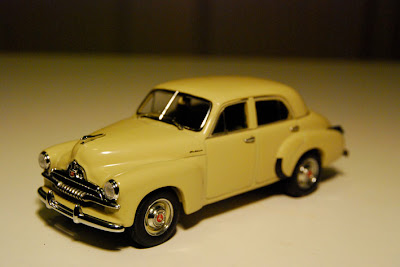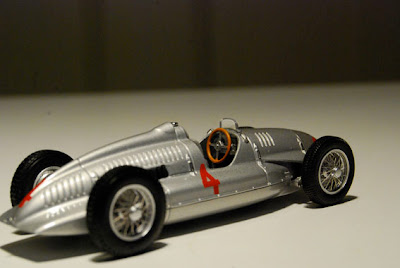At school it was compulsory to study a language, and so I chose French. Mind you I only did four years of French but I did get an "A" for French in the School Certificate exam for 16-year-olds here in Australia. So, on my first day in Paris a mere 20 years later on, I was looking forward to finally roadtesting my excellent Aussie schoolboy French on my first unsuspecting Parisian. A few words into my first French sentence and a Gallic hand went up, like a stop sign, and in English he said "Spare me your French" and walked away.
Undeterred by that rude Parisian curmudgeon, I went on to have a lovely trip through France that year, driving my Citroen GS through the countryside to all quarters, including Mulhouse, where I visited the Schlumpf Museum (but that's another post sometime down the track). And so I have also never lost my fascination for French food, French movies and, yes, French cars, amongst various other acquired tastes of the French kind.
 |
Here's part of one cabinet where French cars rule. While this is by no means
all of my French cars, this is headquarters, I guess. In later posts I'll deal
with the Peugeots on the bottom shelf, the Renaults and other oddities on
the middle shelf, such as Simcas and Panhards, but for starters I thought
I'd take a tour along the top shelf, to visit sporting French sedans with very
big numbers written on their sides. |
|
|
 |
Far left, a Renault Dauphine, winner of the Monte Carlo Rally in 1958. It's
an IXO 1:43 model (in fact all of the model cars here in this post are 1:43) |
|
|
 |
Very much a genuine one-off, this is a modified Altaya model of a Peugeot
403, painted up very nicely in the real livery of the Class C winner at the
Armstrong 500 at Philip Island in 1960 and 61. This Pug was one of the first
cars painted with distinctive stripes to make it easy for pit crews to follow
its progress. The Armstrong 500 race soon relocated to Bathurst and then
evolved into the world famous endurance race most people know about.
But back in 1960, a little 1400cc Pug managed to win its class, which
was for cars 1300-2000cc. A good effort, and obviously a great drive.
I bought this from the modeller who modified it, in an eBay auction. |
|
|
 |
Citroen DS19 from the Rallye de Corse (ie, Corsican Rally). It's another IXO
model, and a not especially nicely made one, I might add. I have my eye
on replacing it with a model of the Citroen which almost won the inaugural
London to Sydney Marathon, but the poor old Corsican will do for the meantime. |
 |
Citroens were very active in rallying at that time. This is something snatched
from a search on Google images, from the Rallye du Maroc. |
|
And now, for a change of pace, some lovely footage courtesy of You Tube from the Rallye du Maroc, complete with casual Citroen drivers, helmetless in their T-shirts, casually changing gears with the column shift while they throw up clouds of dust for les autres to manger
 |
Meanwhile on the other, eastern, side of Africa the Peugeot 404s were
showing the others how to eat dust. This is the 1967 East African Safari winner,
a very nicely made model by Norev. |
And here is some footage of this car being driven around a test course, presumably several years later. I like the in-car 404 driving glimpses the most, but the rest is interesting enough to warrant a run.
 |
Fast forward to 1976 and this is the Peugeot 504 which came home in 9th place
in the East African Safari Rally, in the year when Mitsubishi came in 1-2-3.
This is an Altaya model, not quite as nice close up as the photo might suggest. |
 |
| That's the spirit! A 504 being driven to Sunday School, no doubt. |
 |
This Peugeot 404 Pickup was in the inaugural 1979 Paris-Dakar Rally.
It was a private entry, the extended cab built by the driver, Marc Andre. |
|
 |
While their competitive spirit was spot-on, the more the years advanced the
more stickers cars seemed to wear. Personally, I just prefer one dirty big
number on the driver's door. That spelled 'competition' loud and clear to me. |
And so that's my little introduction to some of my French cars. While Peugeots, Citroens and Renaults seem to be relatively innocuous conveyances for the bourgeosie of France, we French car fans know that beneath those sedate, refined and always interesting facades there lurked cars which loved to be driven. Tough cars which could take a pounding. Cars with suspensions which could cope with third world bumps and hollows. Cars which could in fact win long distance rallies when the fields consisted almost entirely of real production cars rather than purpose built specials. Vive la France!

































